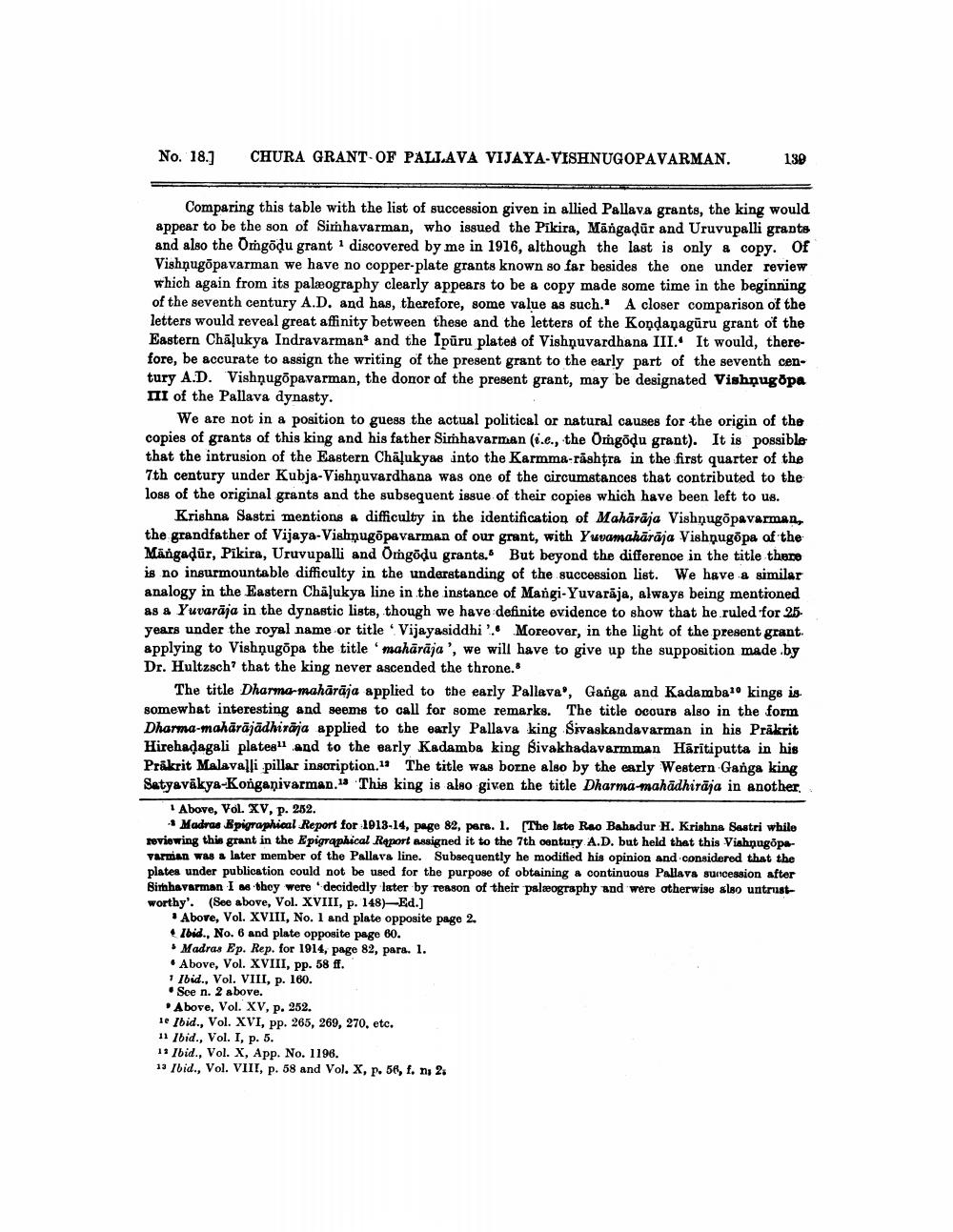________________
No. 18.]
CHURA GRANT OF PALLAVA VIJAYA-VISHNUGOPAVARMAN.
139
Comparing this table with the list of succession given in allied Pallava grants, the king would appear to be the son of Simhavarman, who issued the Pikira, Māngadür and Uruvupalli grants and also the Origödu grant discovered by me in 1916, although the last is only a copy. Of Vishnugopavarman we have no copper-plate grants known so far besides the one under review which again from its palæography clearly appears to be a copy made some time in the beginning of the seventh century A.D. and has, therefore, some value as such.' A closer comparison of the letters would reveal great affinity between these and the letters of the Kondanagüru grant of the Eastern Chālukya Indravarman and the Ipūru plates of Vishnuvardhana III. It would, therefore, be accurate to assign the writing of the present grant to the early part of the seventh century A.D. Vishnugopavarman, the donor of the present grant, may be designated Vishnugopa HII of the Pallava dynasty.
We are not in a position to guess the actual political or natural causes for the origin of the copies of grants of this king and his father Simhavarman (i.e., the Omgödu grant). It is possible that the intrusion of the Eastern Chāļukyas into the Karmma-rashtra in the first quarter of the 7th century under Kubja-Vishnuvardhana was one of the circumstances that contributed to the loss of the original grants and the subsequent issue of their copies which have been left to us.
Krishna Sastri mentions a difficulty in the identification of Maharaja Vishnugopavarman, the grandfather of Vijaya-Vishnugopavarman of our grant, with Yuvamahārāja Vishnugopa of the Mängadür, Pikira, Uruvupalli and Omgõdu grants. But beyond the differenoe in the title there is no insurmountable difficulty in the understanding of the succession list. We have a similar analogy in the Eastern Chalukya line in the instance of Mangi-Yuvaraja, always being mentioned as a Yuvarāja in the dynastic lists, though we have definite evidence to show that he ruled for 25years under the royal name or title Vijayasiddhi'. Moreover, in the light of the present grant. applying to Vishnugopa the title 'mahārāja', we will have to give up the supposition made by Dr. Hultzsch' that the king never ascended the throne.
The title Dharmar mahārāja applied to the early Pallava", Ganga and Kadambalo kings is. somewhat interesting and seems to call for some remarks. The title ocours also in the form Dharma-mahäräjādhiraja applied to the early Pallava king Sivaskandavarman in his Prakrit Hirehadagali plates and to the early Kadamba king Bivakhadavarmman Härītiputta in his Präkrit Malavalli pillar insoription. The title was borne also by the early Western Ganga king Satyavākya-Konganivarman. This king is also given the title Dharma-mahādhiraja in another.
Above, Vol. XV, p. 262.
Madras Epigraphical Report for 1013-14, page 82, pere. 1. [The Iste Rao Bahadur H. Krishna Sastri while reviewing this grant in the Epigraphical Report assigned it to the 7th century A.D. but held that this Vishnugopevarman was a later member of the Pallava line. Subsequently he modified his opinion and considered that the plates under publication could not be used for the purpose of obtaining a continuous Pallava suncession after Birhavarman I as they were decidedly later by reason of their palæography and were otherwise slao untrustworthy'. (See above, Vol. XVIII, p. 148)Ed.]
Above, Vol. XVIII, No. 1 and plate opposite page 2 Ibid., No. 6 and plate opposite page 60. Madras Ep. Rep. for 1914, page 82, para. 1. • Above, Vol. XVIII, pp. 58 ff. 1 Ibid., Vol. VIII, p. 160. • Soe n. 2 above. . Above, Vol. XV, p. 252. le Ibid., Vol. XVI, pp. 265, 269, 270. etc. 11 Ibid., Vol. I, p. 5. 1. Ibid., Vol. X, App. No. 1196. 13 Ibid., Vol. VIII, p. 58 and Vol. X, p. 56, 1. n, 2.




